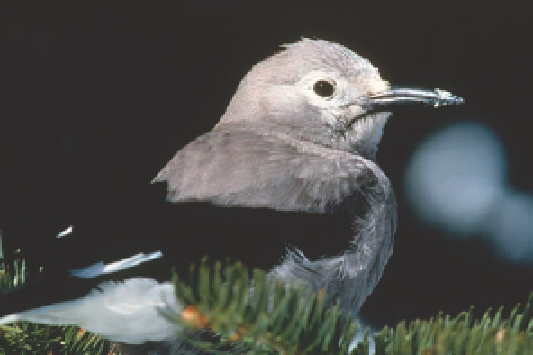Geoscience Reference
In-Depth Information
transmission (such as brucellosis or chronic wasting dis-
ease), and the fostering of a public perception that pro-
benefits are perceived to be fewer agricultural conflicts,
larger herds for hunters (and increased license sales for
the wildlife agencies), and relief from the angst asso-
ciated with knowing that many animals are starving
during harsh winters because of industrial activity and
rural subdivisions.
Pine Seed Dispersal by Birds
one of the most interesting plant-animal interactions
in foothill and escarpment landscapes is that between
certain seed-eating birds and limber and pinyon pines.
Unlike most conifers, these pines have comparatively
large nutritious seeds, and the cone scales tend to hold
the seeds in place, even after the cones have opened.
not surprisingly, the seeds are an important source of
food for various birds, squirrels, and even grizzly bears.
the pines benefit by having their seed dispersed and
sometimes planted by birds and squirrels.
the best-studied example is the clark's nutcracker,
a common bird in the foothills and mountains (fig.
carrying 95 pinyon seeds in a pouch behind its beak for
a distance of 13 miles. Usually the seeds are collected in
late summer and buried on south-facing slopes, which
Fig. 10.16. Browse lines, such as on the taller, older Rocky
Mountain juniper in the background, are formed when
adequate food is not available for elk during the winter. Such
browse lines might have existed for centuries near elk and
deer winter ranges. the two junipers in the foreground are
younger and do not appear to have been heavily browsed,
most likely reflecting reduced populations of the wintering
elk and deer during their development. Photo taken between
Gardiner, Montana, and the border of Yellowstone national
Park. elevation 6,000 feet.
Fig. 10.17. clark's nutcrackers bury the peanut-sized seeds of
limber and whitebark pine in the soil, often on warm south
slopes. Seeds that are not recovered often develop into new
trees, some of which grow in clusters if a bird deposited more
than one seed in a single hole. Photo by LuRay Parker /
Wyoming Game and Fish Department.
availability directly—and indirectly as well, because
human activity forces the ungulates into areas where
the amount and quality of winter forage is either mar-
ginal or where another herd already resides.
Recognizing the problems associated with reduced
winter range, federal and state agencies initiated winter
feeding programs (see chapter 15). From the beginning,
the wisdom of feeding elk and deer in the winter has
sparked controversy, with Wyoming, idaho, and Utah
having state-sponsored feed grounds, whereas Montana
and colorado do not. Aside from rather high costs per
animal, the problems are excess herbivory of trees and
other plants in the vicinity of feeding grounds, disease


Search WWH ::

Custom Search